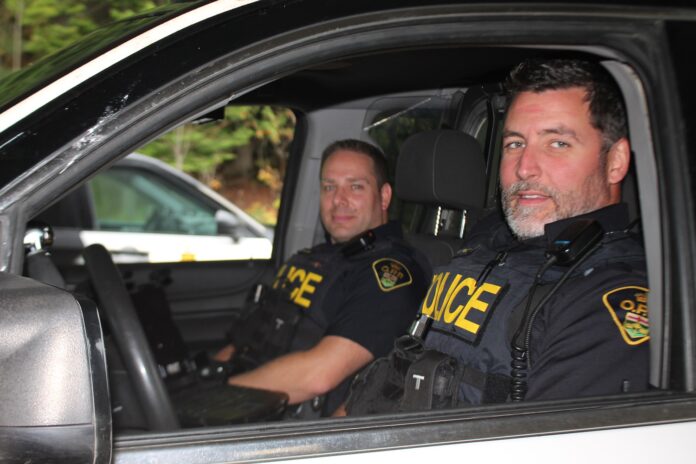It’s a Monday morning at the OPP headquarters in Minden as Const. Joel Imbeau begins to read emails.
He’s looking for referrals from the weekend – from officers who think someone they’ve encountered might need his help.
As of last February, Imbeau is the mental health and addiction liaison officer for OPP – the first permanent appointee since a partnership was launched with the Canadian Mental Health Association Haliburton Kawartha Pine Ridge (CMHA HKPR) in 2021.
Most of the time, there is a CMHA HKPR mental health worker with Imbeau.
Calli Lorente is the manager of integrated crisis services for CMHA HKPR. She is speaking on behalf of the organization as the worker who has been assisting Imbeau is on leave. Other workers have been filling in.
From her perspective, “Mondays are just trying to sort through what has happened over the weekend.”
Lorente says, “how it used to work is the mental health officer worked in the detachment, which they still do, but they used to have a listening ear for any calls that came in that were mental health-related and work with that officer.” The first CMHA appointee on what is called the Mobile Crisis Response Team (MCRT) was Andrew Hodson, who said he’s currently on a leave of absence, working for MP Jamie Schmale. Lorente said Hodson, and his subsequent replacements, worked with different officers, “whereas now, with Joel in the role, it’s extremely helpful because he is able to get all of the referrals from the police. He can confirm consent and then collaborate with the mental health worker to either get out to that call in live time, or do a follow-up piece.”
‘Sparks first step’ towards getting help
Imbeau begins to read a referral; “the complainant indicated their partner is in cognitive decline and has become verbally abusive and aggressive.” The person who called the cops doesn’t feel safe living in the home anymore, and has left. The partner is now living alone. “Now, we have to find a method to support this individual,” Imbeau says.
“We could look at getting him Meals on Wheels, food delivery or grocery delivery, get in touch with the food banks.”
He envisages a referral to the Geriatric Assessment and Intervention Network (GAIN) team at Haliburton Highlands Health Services (HHHS). He suspects GAIN will call in the community paramedicine program, which makes house calls to at-risk seniors.
First, he’ll need to get consent from the person, and, hopefully, be able to speak to family members about what is going on.
He notes there is CMHA HKPR funding for emergency support.
As for the program itself, there are four people funded for the MCRT program through the Ministry of Health and Longterm Care. There is a fifth person funded through the City of Peterborough. These five staff provide MCRT support through partnerships with City of Kawartha Lakes OPP, Peterborough OPP, Peterborough Police Service and Haliburton OPP. The total budget of the program across all regions is $401,000 per year.
Reducing police calls and hospital visits
The MCRT’s are designed to help police and health partners collaborate with service providers in their communities. They are police-led, with an officer and a mental health worker responding together when police are called to a person in crisis. If it is during their working hours, they can go in-person. If after, it may be a follow-up.
“We know the coordination between police services, hospitals and mental health and addictions organizations on a mobile crisis response team leads to an effective use of police and hospital resources within the community,” solicitor general Michael Kerzner says.
OPP commissioner Thomas Carrique adds, “police are called upon to respond to thousands of mental health calls a year. Having officers and health partners work together decreases the impact on related policing and hospital resources, and means improved safety and better outcomes for everyone.”
Sgt. Paul McDonald was the MCRT police lead in Peterborough for about three years. After being stationed in Minden, he identified Imbeau as a member that had the qualities, compassion, empathy, and communication skills that would fit the role needed for a permanent, full-time MCRT lead in the County.
“There’s a lot to be said about having somebody from the community that everybody already knows and can put a name to a face,” McDonald says.
“We’re professionals when it comes to the Criminal Code, Provincial Offences and Highway Traffic acts. We’re not health or mental health experts. If we can create connections for people in crisis, and support them by bringing them to a health or mental health professional, we can focus on crime prevention.”
Imbeau said if it is not a live call, he often follows up with a cold call to the client. He identifies himself as a police officer working with the MCRT in conjunction with CMHA HKPR. “I ask them if they have any questions. I tell them we have good community partners. We have the ability to use CMHA’s resources and facilities if the person suffers from mental illness or addiction.
“Some of them are very engaged and they want the information. Others don’t even want to hear you talk. They hang up. You win your battles. You lose your battles.”
Consent driven
If the person says ‘yes,’ the team begins to try to figure out what is going on; “is there a physical issue, a mental health issue, or both?”
OPP and CMHA HKPR and partners, “try to see the puzzle, and if we can come up with a solution, so this person is supported properly,” Imbeau says.
Without consent, police cannot do anything, other than bring someone to hospital for a psychiatric assessment if they believe the person is a danger to themselves or others, or if they are likely to worsen without treatment. Police can also intervene in an emergency without a court order.
Lorente said when they do get to the door, “you have an officer who looks very much like an officer and a mental health worker who wears a vest but is in casual clothes. They don’t speak the same language and come in at different points of service. So, Joel will go into a call and make sure everything is safe for the mental health worker. He’ll say something like, ‘I actually have somebody who’d be a much better person to talk to you. Are you open to that’?”
Lorente said, “often that first interaction might not get someone engaged in support, but by being offered mental health support, it almost sparks that first step about thinking about service. ‘Maybe this could work’. It might not happen the first call, we might have to follow up, often staff leave a card, saying ‘I get you don’t want this today’, but then we get a call the next day and they actually want to hear what you could offer.”
McDonald said there is still a stigma attached to the program. “We’re not talking about it enough. The police uniform coming to a mental health call. ‘What are police going to do? Let’s close the door. I don’t trust government, organizations, policing’. It’s beating down those barriers and humanizing the badges.”
He recalls OPP being called out 21 times to one family he worked with in Peterborough before they finally got the necessary support services in place. They found temporary, alternative, housing for the family member with issues and got their medicine reviewed and fixed.
“And they came back a completely different person. They came into the office and said, ‘you changed my life just by being there’. Eighteen years of policing and those three years were the most rewarding,” McDonald said.










